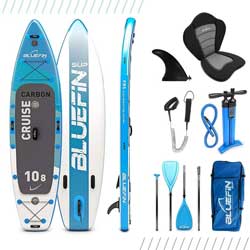 Stand up paddleboarding is a sport that can be done in virtually any body of water – oceans, bays, lakes, canals, rivers, etc.. The problem is that paddleboards are so large (typically about 10 feet long) that transporting them is more of an issue.
Stand up paddleboarding is a sport that can be done in virtually any body of water – oceans, bays, lakes, canals, rivers, etc.. The problem is that paddleboards are so large (typically about 10 feet long) that transporting them is more of an issue.
Many people drive small vehicles, where they can’t transport a 10 foot board. They are left having to rent equipment on location, which can get expensive – and in some places, equipment isn’t even available.
Other people drive trucks, vans or SUV which can accommodate a paddleboard via a roof rack. Although it’s nice to have this option, roof racks are expensive, and not necessarily the most convenient if you need to carry your board long distances. And then there’s the matter of being able to securely lock it.
If you are flying to a tropical island or distant location, you will also have to pay hefty airline fees to transport your board. Plus, when you arrive at your destination, you will need to somehow transport your board from the airport to your hotel or wherever you are staying. There is a lot to deal with here. Alternatively you could rent on location, but rental fees can be steep in resort and tourist locations.
Inflatable Paddleboards Provide Solutions to All of These Issues…
Inflatable paddleboards solve all of these problems above simply by being able to deflate, roll up and store in a compact bag. No having to buy a rack and attach it to the top of your car. No having to haul it to the airport and dish out lots of money. No worrying about your board getting stolen when it’s locked up securely in your car.
Besides being able to move your board more easily, it’s also way easier to store. Some people simply don’t have the space to store a 10 foot board. Even if you do, it’s big and bulky. It becomes much smaller when deflated and rolled into a bag that you can fit in the bottom of your closet or on a shelf.
Some inflatable versions are a little wider and thicker, and therefore automatically add extra stability. This is a nice feature for beginners or people looking for something a little more stable.
What’s Bad About Inflatable Paddleboards…
That said, inflatables tend to bounce in rough water or waves. For lake and flat water paddling, this is a non issue, and many people who get boards exclusively for fun really don’t mind this factor.
The less expensive models are not as “water dynamic” and can take more energy to push through the water. (I’ve used my inflatable paddleboard alongside a friend’s hard board, and it can be challenging to keep up.)
Although they are made of durable materials and are quite sturdy, it is possible for them to get a leak and lose air. This is not the end of the world, because you can patch them, but it is an issue that traditional boards do not have.
You have to pump them up. This is hard work, and it takes time (several minutes). For some people, the extra arm workout is welcomed – for others it’s more of a hassle.
One way I get around this is that I keep my board inflated most of the time (I actually transport it on the top of my car because I already have a roof rack). If you have space to store it, you can deflate the board partially, so you can spend less time pumping it up each time you use it.
Other than that, inflatable and traditional paddleboards offer pretty much the same benefits. You can paddle with them for exercise or recreation, do yoga on them, use them as sit-on-top kayaks and more.

